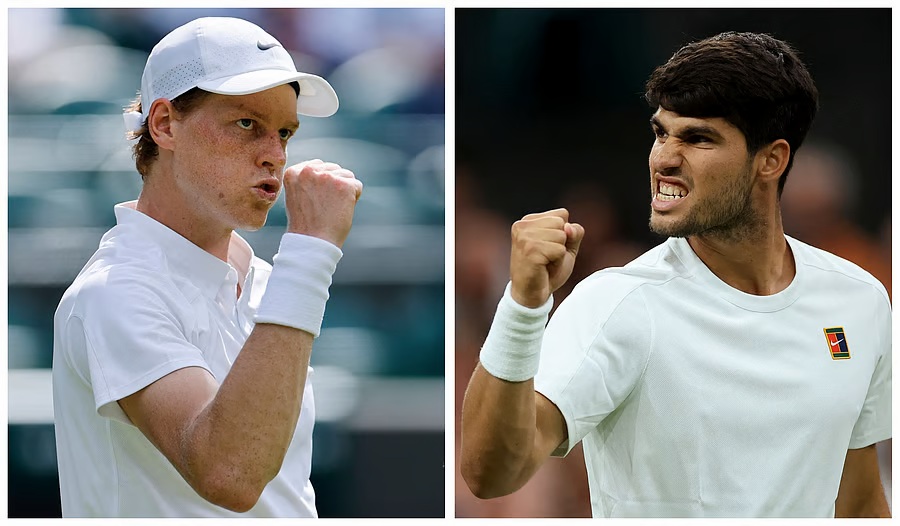Carlos Alcaraz and Jannik Sinner aren’t just rewriting record books with their speed and shotmaking. They are also masters of grip choice and consistency.
Both lock into precise bevels every time they strike the ball, giving them the power, spin, and stability needed for today’s modern tennis game and the ATP Tour.
By studying exactly where they place their hands on the racket, you can adopt the same pro‑level habits and avoid the grip mistakes that hold many club players back.
In this post, we’ll cover:
- The exact bevels these stars use on forehand and backhand
- How those bevels shape their swing mechanics
- Common grip breakdowns among recreational players
The Semi-Western Forehand Grip: Spin, Power, and Versatility
In tennis, the semi-western forehand grip is a popular modern grip that falls between the classic Eastern grip and the relatively extreme full Western grip. In the semi-western, the base knuckle of the index finger and the heel pad generally rest on the racket handle’s bevel 4 (counted clockwise from the top bevel for right-handed players or counter-clockwise for left-handed players).
The semi-western has in recent years become one of the dominant grips of choice for players on the ATP Tour as well as ambitious players at the club and recreational levels alike.
For further background, have a look at the New York Times’ piece on the evolution of grips in tennis, which is highly informative.
Importantly, the semi-western forehand grip is used by two standout talents and stars of the game, Carlos Alcaraz and Jannik Sinner.
Carlos Alcaraz’s Semi‑Western on Bevel 4
This is how Carlos generally approaches his forehand grip technique:
- Index knuckle + heel pad on bevel 4, the classic semi‑western placement
- Enables a steep low‑to‑high path for enormous topspin, even when hitting on the run or from a low ball
- Allows him to flatten out drives when needed, thanks to natural racquet‑face closure
Alcaraz may at times even drifts toward a full western grip on clay, but bevel 4 remains the anchor. That grip demands early racquet prep and perfect spacing. If he misses bevels by millimeters, he risks framing or hanging the ball.
Jannik Sinner’s Strong Semi‑Western on Bevel 4
How does Carlos’ grip compare to Sinner’s forehand grip?
It turns out that their grips are similar, although important and subtle differences can be seen:
- Index knuckle on bevel 4, heel pad just behind, giving at times a “strong eastern” flavour with semi‑western benefits
- Jannik’s grip produces a flatter trajectory than Alcaraz’s big loop, perfect for firing through the court on hard surfaces
- Couples with ultra‑clean footwork to generate depth through timing rather than excessive swing arc
Sinner’s model shows that a bevel 4 doesn’t have to mean gargantuan topspin. He lets the grip and kinetic chain do the work for depth and consistency.
Two‑Handed Backhand: Continental + Eastern/Semi‑Western
Both Alcaraz and Sinner rely on the now‑standard two‑handed backhand, but the hand positions are critical:
- Bottom (dominant) hand: Continental grip on bevel 2
- Top (non‑dominant) hand: Eastern/semi‑western grip around bevel 4
This combo delivers:
- Stability from the continental under‑hand
- Spin and leverage from the upper hand’s bevel 4 placement
- A stroke that stays locked in, even on returns or when stretched wide
Neither player ever shifts these grips mid‑rally—an obsession many club‑level players would do well to emulate.
Why Club Players Struggle with Grip Consistency
At the pro level, players drill their hand’s positioning and bevel placement until it’s second nature. But at club level, common breakdowns include:
- Choking up on the handle when returning heavy serves
- Sliding your hand around the bevels during fast exchanges
- Inconsistent contact on the key landmarks (knuckle vs. heel pad)
Even if you “know” the theory, feeling the bevels and making quick changes under pressure is a different story. That’s where a physical guide can make the difference.
A tennis training aidlike Gripsnake can help you train grips like the pros. Use it during shadow swings, wall drills, or live hitting – or simply while watching TV on your couch! Over time, your hand will snap automatically into the correct bevels, just like Alcaraz and Sinner. No coach reminders needed.
Takeaways: Groove Your Tennis Grips for Game‑Changing Consistency
While most (?) of us won’t ever match Alcaraz, Sinner, or any other tennis gods, there are things we can do to improve our game.
In terms of grips, here are a few things to start:
- Anchor on bevel 4 (knuckle + heel pad) for a modern semi‑western forehand, à la Alcaraz and Sinner.
- Combine bevel 2 + bevel 4 on two‑handed backhands for stability and spin.
- Lock in your bevels early, before the opponent’s ball even crosses the net.
- Practice, practice, practice. On-court and off-court.
You don’t need to swing exactly like Alcaraz or Sinner, just groove their grip habits. If you’re serious about repeatable technique, take the guesswork out of hand placement. Train with purpose, use a tennis grip training tool such as Gripsnake and watch your game transform.
Photo credit: Reuters file

